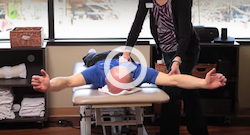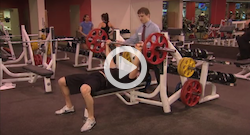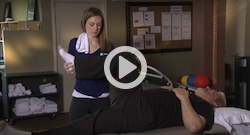Services
Physical Therapy services in Northern Virginia. Serving Alexandria, Fairfax, Prince William and Loudoun Counties.
What is Physical Therapy?
Physical Therapy is a well known and respected profession specializing in the evaluation and treatment of the musculoskeletal system. Physical therapists have the rewarding opportunity to make a positive difference in the quality of their patients’ lives. They help to manage and prevent a wide range of conditions, including orthopedic and soft tissue injuries, sports injuries, fractures and dislocations.
Therapists work to make patients stronger, relieve their pain, and help them regain function so that they can resume activities of daily living such as walking, dressing or bathing. Physical Therapists strive to keep their patients healthy and safe. Therapists understand that recovery continues after the patient has completed direct care. Therefore, physical therapists teach their patients what they need to do at home to manage their condition so they continue to move forward.Life is not a spectator sport, it’s meant to be lived. If pain or limited movement is keeping you from living life to its fullest, physical therapy can help.

Physical Therapy Services
Evaluation – In-depth assessment of your condition by our Doctors of Physical Therapy, focusing on your medical history, the history of your current problem, and a thorough mechanical assessment of your body. We perform top-notch evaluations because we want to uncover ALL of the reasons you may have developed symptoms.

Manual Therapy – Hands-on techniques targeting your problem areas, including soft-tissue mobilization, deep tissue massage, joint mobilization, proprioceptive neuromuscular facilitation (PNF), post-isometric relaxation, neural mobilization and myofascial release designed to assist in the healing process and improve recovery.

Therapeutic Exercise – Customized exercises, prescribed by your therapist to address strength, flexibility, balance, endurance and other functional impairments that are uncovered during the evaluation.
Strength and Endurance Training – Carefully prescribed doses of exercise using body weight, manual resistance, free weights and other specialized strengthening equipment that help to improve your physical strength, endurance, performance and ability to avoid future injury.
Stretching – Hands-on muscle relaxation and lengthening techniques, targeting muscle groups that are in spasm, protecting sore joints or nerves, or are just short from years of disuse. The type of stretch and dose are carefully chosen by your therapist, and pictures with descriptions are given to help you work on them at home.
Neuromuscular Re-education – Verbal, manual, and device-assisted treatments, focusing on teaching and training correct muscle timing, activation, and coordination. This treatment strategy helps to make the most of the mobility and strength gains you get in therapy.
Gait Training – Expert movement assessment and re-training using state of the art technology, both for high-level running technique and for normal walking patterns. You take thousands of steps per day, so good mechanics really matter!

Cardiovascular Conditioning – Evidence based exercise prescription, focusing on your heart and lung health. Your overall health, wellness, life expectancy, and healing abilities are significantly influenced by how healthy your heart and lungs are, so we make this a priority. Our clinics are equipped with stair-climbers, treadmills, stationary bicycles, ellipticals, upper body ergometers, and other modes of cardiovascular training to help get you on track.
Education – You are the most important person in the rehab process. Your rate of improvement increases tremendously if you understand your condition, believe in the plan of care, know how to measure your success, and know what to expect along the way. We take pride in educating you about every aspect of your care, because we know how much it matters.
Equipment Prescription – You need the right tools to do the job well. A home exercise program that includes equipment like resistance bands, tape, braces, heat packs, cold packs, foam rollers, insoles, theracanes, balance boards, and stretch-out straps can mean the difference between momentary relief and sustained results!
Therapeutic Modalities – We consult the latest research to guide our use of therapeutic modalities. In the right conditions, your therapist will utilize Heat/Cold packs, ultrasound, electrical stimulation, iontophoresis, phonophoresis, cervical traction, or lumbar traction to further improve your recovery.
Areas of Treatment
- Pain
- Weakness
- Stiffness
- Balance Deficits
- Fatigue
- Poor Endurance
- Poor Flexibility
- Poor Posture
- Sprains and Strains
- Sports Injuries
- Work Injuries
- Post-Surgical Conditions
- Personal and Auto Injuries
- Nerve Injuries (Carpal Tunnel Syndrome, Sciatica, etc.)
- Orthopedic Injuries
- Acute and Chronic Conditions
People who cannot tolerate traditional exercise programs find the water to be the perfect medium for exercise. It promotes pain relief due to the buoyancy property of water that provides support for your joints. It decreases weight bearing so that compression of the joints is minimized. The therapeutic benefits of water include the ability to perform functional movements that may otherwise be inhibited on land such as walking and squatting. The water provides support and therefore patients experience a reduced fear of falling and greater mobility.
Aquatic therapy promotes increased venous return and assists in improving circulation which aids in decreasing swelling and increasing range of motion. Participating in therapy in the water allows patients to work on balance training and postural awareness while strengthening weak muscles and improving overall endurance. With all of these benefits, it is no wonder that our aquatic programs are especially popular.
Blood Flow Restriction (BFR) therapy is a revolutionary treatment that is rapidly gaining popularity in the field of Physical Therapy. By restricting blood flow to certain muscles, BFR therapy helps to accelerate muscle growth, improve strength, and enhance recovery from injuries.
Key Benefits of BFR Therapy:
- Improved Muscle Growth: BFR therapy works by restricting blood flow to the muscles being targeted during exercise. This restriction triggers a series of physiological responses that lead to an increase in muscle growth. This means that patients who undergo BFR therapy can see significant improvements in muscle mass and strength.
- Faster Recovery: Because BFR therapy stimulates muscle growth and repair, it can help to speed up the recovery process after an injury. This means that patients who undergo BFR therapy can return to their normal activities faster than those who don’t.
- Reduced Risk of Injury: By targeting specific muscles, BFR therapy allows patients to strengthen those muscles without putting undue stress on their joints or other body parts. This reduces the risk of injury and makes it possible for patients to continue exercising and building strength even when they have an injury.
- Increased Endurance: BFR therapy can also improve endurance by increasing the number of capillaries in the muscles being targeted. This means that patients who undergo BFR therapy can exercise for longer periods of time without feeling fatigued.
- Non-Invasive Treatment: BFR therapy is a non-invasive treatment that can be performed in a physical therapy office or at home with the right equipment. This makes it an attractive option for patients who want to avoid surgery or other more invasive treatments.
- Versatile Treatment: BFR therapy can be used to treat a wide range of conditions, including osteoarthritis, tendonitis, and muscle strains. It can also be used to enhance athletic performance and improve overall fitness.
If you are interested in BFR therapy, click the link below to schedule an appointment and see if it is right for you. With its numerous benefits and versatile applications, BFR therapy is quickly becoming a go-to treatment for patients who want to improve their strength, endurance, and overall fitness.
Physical Therapy is an integral part of breast cancer rehabilitation. Those undergoing treatments for breast cancer often face surgery. Physical therapists can work with women to alleviate symptoms caused by surgical intervention or medical treatment for cancer.
Our therapists can help:
- Reduce Pain
- Improve Strength
- Mobility & Flexibility
At The Jackson Clinics, our goal is to assist you through the course of cancer treatment and help you return to your regular activities. Current breast cancer treatment may include chemotherapy, radiation therapy, and endocrine therapies. Some treatments may lead to physical or functional impairments which can be amenable with rehabilitation. In the past, many of these impairments, which may include pain, fatigue, lymphedema, weakness, loss of mobility, or numbness and tingling, have gone untreated.
Here, at The Jackson Clinics, we utilize the most up to date standard of care called the Prospective Surveillance Model to assist in prevention, and to help minimize the effects of cancer treatment.
The Prospective Surveillance Model, or PSM, is a proactive approach to periodically examining patients and providing continued assessment during and after disease treatment, often in the absence of impairment. This model allows for early detection and intervention of physical impairments known to be associated with cancer treatment. Research has shown that the PSM reduces post-operative complications related to breast cancer treatment and lowers the overall cost of treatment by being proactive in early detection of physical complications.
The PSM is divided into 3 phases.
Phase 1: The first phase includes a preoperative evaluation. This evaluation consists of a thorough assessment of current level of function, exercise habits and allows the clinician to establish a baseline from which to follow the patient and detect change over time. This visit also provides education regarding the postoperative plan of care, including postoperative exercises, and advice for returning to activities during and after treatment. Further, the preoperative visit allows for discussion regarding known risk factors and adverse effects of cancer treatment.
Phase 2: The second phase of PSM includes a postoperative evaluation. This visit repeats baseline tests and measures and further reinforces education regarding exercise, and return to activity. An individualized exercise program is prescribed for independent exercise throughout the course of cancer treatment, aimed at improving function and preventing impairments related to treatment.
Phase 3: The third and final phase consists of ongoing surveillance. Baseline tests and measures are repeated at each follow- up visit in an effort to identify changes and to detect early signs of physical impairment. If impairments are detected, rehabilitation may be initiated. This proactive approach promotes early intervention to optimize recovery and return to pre-operative level of function.
At The Jackson Clinics, we strive to assist you in reaching your optimal level of function and achieving your goals of health and wellness. We believe taking a proactive approach via the Prospective Surveillance Model is the best way to reach these goals together.
Schedule your appointment today with one of our Certified Lymphedema Therapists!
Your body is a complex mechanical system. To prevent mechanical breakdown with common activities like standing, walking and running, the joints and muscles of your legs and feet need good alignment, strength and endurance. Our therapists are trained to assess your mechanical system using a state-of-the-art biomechanical movement evaluation. Based on this analysis, they will prescribe stretches, exercises, and in some cases, insoles or custom orthotics for your feet. Your orthotics will be molded directly to your foot, and your therapist will prescribe alterations to maximize your pain relief and performance when you wear them.
The Jackson Clinics provides complimentary orthotics check-ups every year to make sure they are still optimally serving your needs. During that 15 minute screen, the therapist will also check in on your exercise routine and progress the intensity to fit your goals.
Physical Therapy for Lymphedema
The good news is Lymphedema is a treatable condition that can be controlled through the combination of:
- Manual lymphatic drainage
- Multi-layered compression bandages & garment fitting
- Exercising, strengthening & conditioning the affected extremity
- Balance training
- Aquatic therapy
- Thorough patient education with precaution awareness
Our program will make significant improvements by restoring functional mobility and strength, reducing swelling and pain, and improving cosmetic appearance.
How physical therapy helps:
Physical therapy can be utilized to improve range of motion, strength, endurance and function before and after surgery, chemotherapy and radiation treatments. Our goal is to help patients return back to normal activities, such as work, exercise and hobbies, as quickly and safely as possible.
Signs and symptoms of Lymphedema?
Lymphedema can occur in any body part. Some common early symptoms include:
- Tightness, swelling or thickening anywhere in the extremity. Initially the swelling may fluctuate but over time it worsens.
- A burning sensation or tingling sensation radiating down the extremity.
- Complaints of heaviness or aching of the extremity.
- Inability to wear rings, jewelry, watches or clothing secondary to edema.
The Jackson Clinics therapists provide pediatric services for orthopedic, neurological, or developmental conditions on an outpatient basis. Ages can vary from birth to school-aged children.
Our pediatric therapists will:
- Assist in development of age appropriate gross motor skills
- Assist in functional independence for home, community and school
- Provide parent education
- Focus on strengthening, stretching, balance and exercises based on needs determined at evaluation
Conditions treated include:
- Torticollis
- Toe Walking
- Cerebral Palsy
- Downs Syndrome
- Developmental Delay
- Osteogenesis Imperfecta
- Orthopedic conditions such as hip dysplasia, fractures, and sprains.
Pelvic Floor Physical Therapy is a non-surgical approach to rehabilitation of dysfunctions in the pelvis that contribute to bowel, bladder, sexual health, and pain complaints. Just because these dysfunctions are common does not mean they should be suffered through, and seeing a pelvic health physical therapist specialist can help.
Our specialized physical therapists will:
Evaluate the alignment, musculature, fascial systems, and movement patterns in the pelvis and body for issues that activate your pain and decrease your quality of life. Then they will develop a treatment program customized to your specific needs.
Common conditions treated include:
- Pelvic, low back, and hip pain
- Urinary and bowel dysfunction
- Antepartum/postpartum care, pain in pregnancy
Locations and specialists are subject to change. Please call 540-687-8181 for the most current information.
3D Running Exam at The Jackson Clinics
Precision Insights: Dive deep into your running mechanics with our state-of-the-art 3D analysis. Discover how your body moves, identifies potential risks for injury, and unlocks areas for improvement.
Personalized Recommendations: No two runners are alike, and neither are their needs. Receive tailored recommendations and exercises designed specifically for you, helping you reach your goals efficiently and effectively.
Expert Guidance: Our experienced team of physical therapists and running specialists are with you every step of the way. Get insights, tips, and strategies to enhance your technique and optimize your performance.
RunDNA Runner Portal: Your Running Journey, Elevated
Your Personal Hub: Access your individualized Runner Portal to view your exam results, personalized improvement plans, and track your running milestones—all in one convenient location.
Exam Results at Your Fingertips: Review your detailed 3D analysis results anytime, anywhere. Understand your gait, stride, footstrike, and more, empowering you with knowledge to run stronger.
Personalized Improvement Plans: Stay on track with your customized plan designed by our Running Specialist (Doctor of PT). Explore exercises, stretches, and drills tailored to enhance your performance and prevent injuries.
Mileage Tracking: Keep tabs on your progress with built-in mileage tracking. Set goals, track your runs, and celebrate milestones as you conquer new distances.
Direct Communication: Connect with your Running Specialist effortlessly through the portal. Ask questions, seek advice, and receive ongoing support to ensure you’re always running at your best.
What to Expect:
Comprehensive Analysis: Through our detailed 3D running exam, we’ll analyze your gait, stride, footstrike, and more. Uncover the nuances of your running form like never before.
Individualized Report: Receive a detailed report breaking down your results, highlighting strengths, areas of concern, and actionable steps to enhance your running experience.
Hands-On Coaching: Sit down with our Doctors of Physical Therapy to discuss your report, ask questions, and develop a personalized plan that fits seamlessly into your lifestyle.
Elevate your performance with elite-level training led by our team of Doctors of Physical Therapy and Exercise Scientists at The Jackson Clinics. Rooted in the latest exercise science research, our programs are meticulously crafted to help you achieve your peak potential.
Each session is a personalized 1-hour experience, completely one-on-one with our clinical specialists. Whether you’re an athlete aiming for top-tier performance or an individual striving for fitness excellence, our experts are here to guide you every step of the way.
Located in Northern Virginia, we proudly serve Loudoun, Fairfax, and Arlington counties. Our fitness training, delivered by clinical specialists, bridges the gap between traditional workouts and cutting-edge science. Experience the difference with The Jackson Clinics.
EXPERT TRAINERS, EXCEPTIONAL RESULTS
What is TMD?
Temporomandibular dysfunction (TMD) refers to conditions causing pain and impairments of the temporomandibular joints (TMJ) and surrounding muscles. The joint and muscles work together to control movement of the jaw, and they require coordination to complete daily tasks, such as yawning and chewing. Frequently, TMD includes symptoms such as clicking, popping, locking and grinding in the jaw. You may also experience headaches, dizziness, sinus pain and ear ringing related to TMD. The TMJ and neck have a close relationship, and often treatment of both can lead to the greatest improvements.
The GOAL of Physical therapy:
The goal of Physical Therapy treatment for Temporomandibular Dysfunction (TMD) is to provide pain relief using a variety of techniques to improve your range of motion through exercise and manual therapy and to improve posture and muscle imbalance. There may be modifications to your activities or work station that would be helpful as well.
Physical therapy treatment
Our physical therapists will work closely with your dentist or physician to establish an individualized treatment plan based on results from a comprehensive evaluation. The most current treatment options will be utilized to ensure the best outcome for decreased pain and improved function. Your customized care plan will use a variety of treatment modalities, such as:
- Manual therapy to the joints and surrounding muscles
- Education on lifestyle changes and behavior modification
- Specific exercises to improved coordination and mobility
- Modalities for pain relief
Trigger Point Dry Needling uses small, thin needles to stimulate underlying myofascial trigger points, muscular and connective tissues for the management of many orthopedic conditions, both acute and chronic. By inserting a needle into the dysfunctional tissue, it often leads to a contraction of the muscle which then stimulates a relaxation. This leads to a reduction of pain, improvements in flexibility and a restoration of normalized movement when combined with corrective exercises.
WHAT IS A MYOFASCIAL TRIGGER POINT?
A myofascial trigger point is a hyperirritable spot within a taut band of skeletal muscle that produces local or referred pain. The trigger point can lead to increased pain, decreased flexibility and decreased muscle function if not treated. Trigger point dry needling is a safe, effective and efficient treatment technique to release these painful spots.
WHAT TYPE OF PROBLEMS CAN BE TREATED?
Muscle dysfunction can be the primary or secondary contributing factor to many neuromusculoskeletal conditions.
WHAT YOU NEED TO KNOW:
- Dry needling must be specifically prescribed by a physician.
- Dry needling is not covered by insurance; it is a cash based modality.
TRIGGER POINT DRY NEEDLING
This treatment is not acupuncture. Modern dry needling is based on Western neuroanatomy and modern scientific study of the muscles and nervous system. This modality can only be done by trained clinicians.
Improve dizziness symptoms and balance problems.
Therapy for vestibular disorders can take many forms. The type of exercise utilized depends upon the unique problems that the individual demonstrates during the evaluation. Some exercises are geared toward helping with balance, some with helping the brain resolve differences in the inner ear signals, and some with improving the ability to visually focus. In addition, general exercise is often prescribed to improve overall physical health and well-being.
Our specialized therapists will:
- Give exercises that make symptoms more manageable
- Provide coping strategies to make recovery quicker and easier
- Decrease fatigue – often a side effect of dizziness
- Improve balance, confidence, and safety
Disorders treated:
- BPPV (Benign Paroxysmal Positional Vertigo)
- Unilateral loss (ie: vestibular neuritis or acoustic neuroma
- Bilateral loss (ie: gentamicin toxicity)
- Meniere’s Syndrome; Perilymphatic Fistula
- Post-traumatic vertigo
- Multifactorial disequilibrium of the elderly










